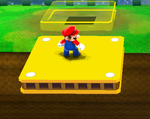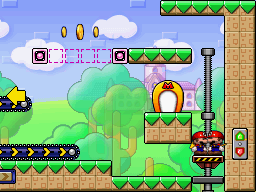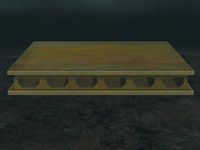Lift: Difference between revisions
m (Text replacement - "({{[Ff]oreign names[^{}]+[^\n])}}" to "$1 }}") |
|||
| Line 18: | Line 18: | ||
====''Donkey Kong Country 3: Dixie Kong's Double Trouble!''==== | ====''Donkey Kong Country 3: Dixie Kong's Double Trouble!''==== | ||
In ''[[Donkey Kong Country 3: Dixie Kong's Double Trouble!]]'', lifts consist of wooden planks. Some are activated when [[Dixie Kong]] or [[Kiddy Kong]] ride them, and some are activated automatically. They are | In ''[[Donkey Kong Country 3: Dixie Kong's Double Trouble!]]'', lifts consist of wooden planks. Some are activated when [[Dixie Kong]] or [[Kiddy Kong]] ride them, and some are activated automatically. They are found primarily in mills, but also appear in [[Fire-Ball Frenzy]]. Additionally, a single horizontally moving lift appears during the first boss fight with [[Baron K. Roolenstein]]. | ||
===''Super Mario'' series=== | ===''Super Mario'' series=== | ||
Revision as of 23:18, June 13, 2022
| It has been suggested that this page be split into the following: Lift, Flatbed Ferry, Elevator (Mario & Wario). (discuss) |
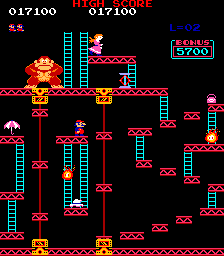
Lifts[1] (also known as elevators[2] or Moving Platforms[3]) are objects that appear throughout the Mario franchise. They are simply platforms that go up or down, in order to transport a game character or object to different heights. Some move by themselves, while others are controlled by the player. The ones in the Yoshi franchise have a distinct zigzag pattern and are called Flatbed Ferries.
History
Donkey Kong franchise
Donkey Kong
In Donkey Kong, two sets of lifts appear in 75m: one set going up, the other set going down. Lifts appear to work via a chain-like mechanism. When an elevator reaches the end of its path, it disappears, and a new one appears at the beginning of the path, as opposed to a single elevator going up and down.
Donkey Kong (Game Boy)
Lifts also appeared in the Game Boy version of Donkey Kong. In some levels, levers can be pulled to make them change direction.
Donkey Kong Country
In Donkey Kong Country, many elevators are in the latter half of Elevator Antics. They either move up or down from a steel pole. The elevator lifts appear to be filled with coal.
Donkey Kong Country 3: Dixie Kong's Double Trouble!
In Donkey Kong Country 3: Dixie Kong's Double Trouble!, lifts consist of wooden planks. Some are activated when Dixie Kong or Kiddy Kong ride them, and some are activated automatically. They are found primarily in mills, but also appear in Fire-Ball Frenzy. Additionally, a single horizontally moving lift appears during the first boss fight with Baron K. Roolenstein.
Super Mario series
Super Mario Bros. / Super Mario Bros.: The Lost Levels
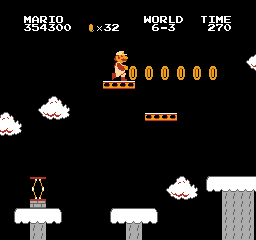
Lifts are common in some levels of Super Mario Bros. Vertical Lifts[4] first appear in World 1-2, where they continuously move upwards or downwards with new ones being dispensed from the bottom or top. World 1-3 introduces a version of this lift that remains onscreen and simply moves up and down, as well as Horizontal Lifts[4] that move back and forth. World 3-3 introduces Flimsy Lifts, which are stationary lifts that move downwards if Mario or Luigi stands on them, as well as Balance Lifts. Balance Lifts consist of two platforms attached to a pulley, where if Mario/Luigi stands on one of them, that lift is weighed down, while the other is hoisted upwards. However, if Mario/Luigi stands on said lift too long, and the lift he is on moves too far down due to his weight, then both lifts will break off the pulley and fall into the void below, causing Mario/Luigi to score 1,000 points, oddly enough. The lifts are solid, meaning Mario and Luigi cannot land on top by jumping through them. Their original visual appearance in Super Mario Bros. is likely derived from the appearance of the platforms that make up 100m in Donkey Kong, while, in Super Mario Bros.: The Lost Levels, they are made of mushrooms. However, in the Super Mario All-Stars version, both games feature them in their normal form.
Super Mario Bros. 3 / Super Mario Advance 4: Super Mario Bros. 3
In Super Mario Bros. 3, lifts are made of wood, much like Hard Blocks in the game. Two new varieties are introduced: Rail Lifts,[5] which travel along a track, first appearing in World 1-6, and moving Flimsy Lifts, which fall all the way to the bottom of the screen as soon as Mario or Luigi lands on one, first appearing in World 1-4. In Super Mario Advance 4: Super Mario Bros. 3, Super Mario Bros.-styled metallic lifts of various types are found in the World-e levels Wild Ride in the Sky, Caped Escape, Koopaling Confusion, Classic World 1-2, Classic World 1-3 and Classic World 1-4, while several stationary lifts in their Super Mario World design can be seen in the level Rich with Ropes. In A Towering Tour, some fast-moving gray-colored lifts also appear. They behave similarly to the metal lifts, only being shaped like the normal lifts, and the aforementioned color difference. They also follow a shorter path compared to normal lifts, which adds to the difficulty of staying on top of them. These blocks also have a line-guided variant, which move even faster than their non-line-guided variants.
Super Mario World
Lifts reappear in Super Mario World, this time with a gray or cream color. The Rail Lift is back under the name Pulley Lift[6] (or Pully Lift).[7] A platform on a swing is known as a Single Swing Lift, coming with a brown version that activates and rotates around a central pivot point when a player steps on it and a gray version that swings in perpetual motion, as well as a set of three swinging gray platforms known as a Triple Swing Lift. A set of gray Rotating Blocks that cannot spin with wings is known as a Flying Platform. A raft of skulls on lava is known as a Skull Raft. An orange, diagonal-facing platform with a grassy top is known as a Naname Lift, and a thicker, upright grassy platform with a countdown timer in the middle is known as a Count-Lift. Additionally, a mushroom variant of the Balance Lift is known as a Piston Lift.
Super Mario Land 2: 6 Golden Coins
Super Mario Land 2: 6 Golden Coins introduces a Hone Lift that rises upward when jumped on, which is a hazard as the sole section of the game that includes them features spikes above them. They basically act as the opposite of the Flimsy Lift, although the Hone Lift freezes in place when Mario is off of it, unlike the Flimsy Lifts in this game.
Super Mario 64 / Super Mario 64 DS
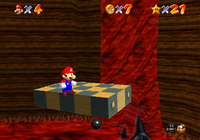
Most lifts in Super Mario 64 and Super Mario 64 DS have a tan-and-green checkerboard pattern on them. In some courses, such as Whomp's Fortress and Vanish Cap Under the Moat, pairs of lifts move along and rotate around both sides of a vertical beam, flipping when they reach the top. In the Hazy Maze Cave and Lethal Lava Land, lifts move along chains of black spheres when stepped upon. Additionally in the Hazy Maze Cave, large orange lifts with yellow and black trim appear to take the player between floors, and a unique controllable lift called the Work Elevator appears in one part of the course. Special lifts called Arrow Lifts appear in Wet-Dry World, moving back and forth when stepped upon. Also in Wet-Dry World, an Express Elevator appears embedded into some metal mesh. Stepping on the portion outside the mesh causes it to lower, at which point the player has a limited time to reach the portion inside the mesh and ride it to a Power Star.
Super Mario Galaxy 2
In Super Mario Galaxy 2, lifts appear as yellow platforms that raise Mario up, then flash blue and disappear. They cannot be controlled by the player. They appear in Sky Station Galaxy, while giant versions of them are found in Supermassive Galaxy.
Super Mario 3D Land
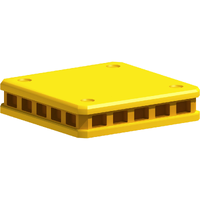
Lifts appear in Super Mario 3D Land, having the same design and function as that of Super Mario Galaxy 2. However, they never disappear, unlike in the previous game.
Super Mario 3D World / Super Mario 3D World + Bowser's Fury
Lifts return in Super Mario 3D World and Super Mario 3D World + Bowser's Fury, having the same appearance and effects as they did in Super Mario 3D Land.
Super Mario Maker / Super Mario Maker for Nintendo 3DS
Lifts reappear in Super Mario Maker and Super Mario Maker for Nintendo 3DS as tools. The direction in which they initially move can be pre-set, and they can move in a set path when placed on a track. When shaken, they turn into Flimsy Lifts, which are colored blue this time and will start moving on a track once stepped on. In the Super Mario World style, when placed on a track, the lift uses the same tile as the Chainsaw from that game, albeit with minor differences.
Super Mario Run
Lifts appear in Super Mario Run, where they run on Tracks in several levels. When Mario stands on a Lift, he stops moving until he jumps. After Mario gets off of a Lift, it disappears. The lifts' designs are similar to the falling platforms in the final Bowser battle in New Super Mario Bros. 2.
Super Mario Odyssey
Lifts reappear in Super Mario Odyssey, where they have the same appearance as they did in Super Mario 3D World. Lifts that use their Super Mario Bros. sprites also appear in 2D segments.
Super Mario Maker 2
Lifts also appear in Super Mario Maker 2, where this time, their length can be changed. In the Super Mario 3D World style, they take the form of Cloud Lifts.
Super Paper Mario
A few lifts are found in The Bitlands in Super Paper Mario. This time, they are pixelated and resemble the orange ones found in Super Mario Bros.
Mario & Luigi series
Mario & Luigi: Superstar Saga / Mario & Luigi: Superstar Saga + Bowser's Minions
In Mario & Luigi: Superstar Saga and Mario & Luigi: Superstar Saga + Bowser's Minions, a lift that connects to Little Fungitown can be found at the end of Teehee Valley, and a couple of Lifts can be found in Guffawha Ruins. Also, the Spin Blocks, which can be found in Gwarhar Lagoon, were introduced in this game as well.
Mario vs. Donkey Kong series
Mario vs. Donkey Kong
Lifts similar to the ones from Donkey Kong appear in Mario vs. Donkey Kong. They continuously appear at one end of a track and move in a direction before disappearing at the other end. Sometimes, the direction of all lifts in a level can be changed at once by pressing a Direction Switch.
Mario vs. Donkey Kong 2: March of the Minis
Lifts can be used by Mini Marios in Mario vs. Donkey Kong 2: March of the Minis. They are introduced in Mushroom Mayhem, Room 1-5, and continue to appear in later levels in the game.
The object is a platform attached to a pole. On a wall nearby, there is also a lift button that has two red arrows facing away vertically.
To use a lift, a toy has to get onto it first, then the player must use the button by using the touchscreen to tap on one of the two arrows to elevate the lift or bring it down. Once tapped, the lift cannot be interrupted by tapping on the button again until it reaches to a certain level to stop on. Lifts can hold up to two Mini Marios.
Yoshi Topsy-Turvy
Lifts can be used by Yoshi in Yoshi Topsy-Turvy. They come in a green zig-zag pattern and a brown rocky pattern and are attached to chains by rails. The patterns are just for show and do not affect the lifts' behavior. When the player tilts their Game Boy Advance system, the lifts will swing back and forth and move along the rails. Half Lifts (ハーフリフト[8]) also appear, which are miniature versions of lifts. They come in the same two patterns as normal lifts, but they are not attached to rails and will only swing when the Game Boy Advance system is tilted.
Super Smash Bros. series
Super Smash Bros. Brawl
In Super Smash Bros. Brawl, lifts from Donkey Kong appear in the stage 75 m, which also reappears in Super Smash Bros. for Wii U and Super Smash Bros. Ultimate. They act same as they do in the original Donkey Kong due to the stage being an exact remake of the original level. Lifts also appear in the Mushroomy Kingdom stage, with the same placement and function as in World 1-2 of Super Mario Bros., though they are pass-through platforms and appear as rusted, due to the stage's aged appearance.
Super Smash Bros. for Nintendo 3DS
In Super Smash Bros. for Nintendo 3DS, lifts from Super Mario 3D Land appear as platforms in the auto-scrolling 3D Land stage. The match begins on three stationary lifts. During the second portion, players fight on four multi-colored lifts as they transition them to the third portion of the stage; on the way there, some platforms may collide into protruding rocks, altering their angle. In PictoChat 2, one of the drawings that may appear is a row of blocks between a pair of continuously moving lifts from World 1-2 of Super Mario Bros.
WarioWare series
Lifts on tracks from Super Mario Bros. 3 appear in the microgame Super Mario Bros. 3-Lift in WarioWare: Twisted! and WarioWare Gold (renamed to simply "Super Mario Bros. 3" in the latter). The player has to rotate the system to move the platforms and make Mario avoid the multiple enemies coming for him. In the third level, another lift appears along with Luigi on it, who also needs to be protected.
Captain Toad: Treasure Tracker (Nintendo Switch)
Lifts reappear in the Nintendo Switch version of Captain Toad: Treasure Tracker, replacing the Propeller Platforms due to the lack of the microphone.
Special types of lifts
- Arrow Lift (Super Mario 64)
- Arrow lift (New Super Mario Bros. series)
- Blarggwich
- Directional Lift
- Donut Block
- Flatbed Ferry
- Lava Lift
- Liftoglobin
- Liquid lift
- Rotary Lift
- Scale Lift
- Switchboard
- Tilt Lift
Profiles
Rail Lift
Super Mario Bros. 3
- 3DS Virtual Console manual bio: "Travel along rails."
Names in other languages
| Language | Name | Meaning | Notes |
|---|---|---|---|
| Japanese | リフト Rifuto レールリフト[9] Rēru Rifuto (Super Mario Bros. 3) 線リフト[10] Sen Rifuto (Super Mario World) エレベーター[11] Erebētā (Mario & Wario) |
Lift Rail Lift Line Lift Elevator |
|
| Chinese | 升降梯 Shēngjiàngtī 升降台 (Super Mario Maker 2) Shēngjiàng Tái[?] |
Lift Lift Platform |
|
| Dutch | Platform[?] | Platform | |
| Italian | Ascensore Piattaforma[?] |
Elevator Platform |
|
| Russian | Платформа[?] Platforma |
Platform | |
| Spanish | Ascensor[?] | Elevator |
References
- ^ Super Mario Maker in-game name
- ^ Musa, Alexander, and Geson Hatchett. Super Mario 3D World PRIMA Official Game Guide. Page 167.
- ^ Mario vs. Donkey Kong 2: March of the Minis (Europe) in-game name
- ^ a b Hiroo Tochikubo, How to Win at Super Mario Bros., Tokuma Shoten, 1987, ISBN 4-19-720003-XC. Page 47.
- ^ Super Mario Bros. 3 English instruction booklet, page 19.
- ^ M. Arakawa. Nintendo Mario Mania Player's Guide. Pages 70 and 71.
- ^ Nintendo Power Advance v.4, page 29.
- ^ 「ヨッシーの万有引力任天堂公式ガイドブック」 (Yoshi Banyū Inryoku Nintendo Kōshiki Guidebook), page 20.
- ^ Super Mario Bros. 3 Japanese instruction booklet, page 17.
- ^ Shogakukan. 2015. Super Mario Bros. Hyakka: Nintendo Kōshiki Guidebook, Super Mario World section, page 60.
- ^ Mario & Wario instruction booklet, page 9.
- Platforms
- Hazardous objects
- Donkey Kong (game) objects
- Donkey Kong (Game Boy)
- Donkey Kong Country objects
- Donkey Kong Country 3: Dixie Kong's Double Trouble! objects
- Mario & Wario
- Mario vs. Donkey Kong objects
- Mario vs. Donkey Kong 2: March of the Minis
- Super Mario Advance 4: Super Mario Bros. 3 objects
- New Super Mario Bros. objects
- New Super Mario Bros. 2 objects
- New Super Mario Bros. U objects
- New Super Mario Bros. Wii objects
- Super Mario 64 objects
- Super Mario 64 DS objects
- Super Mario 3D Land objects
- Super Mario 3D World objects
- Super Mario Bros. objects
- Super Mario Bros. 3 objects
- Super Mario Bros.: The Lost Levels objects
- Super Mario Galaxy 2 objects
- Super Mario Maker objects
- Super Mario Maker 2 objects
- Super Mario Odyssey objects
- Super Mario Run objects
- Super Mario World objects
- Super Paper Mario objects
- Super Smash Bros. Brawl
- Super Smash Bros. for Nintendo 3DS / Wii U
- Yoshi Topsy-Turvy objects

